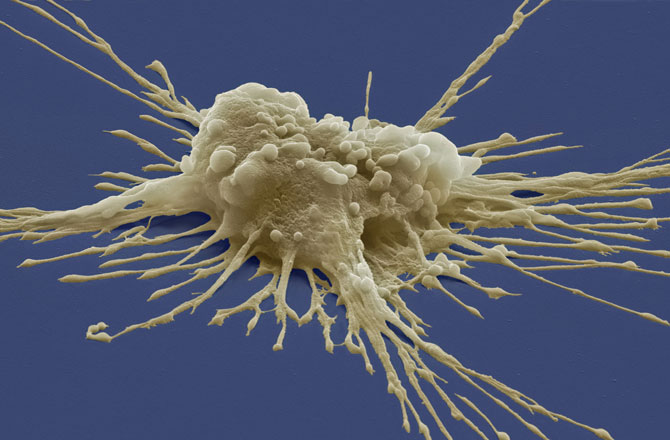Therapeutic stem cells implant has been used for the last 40 years. It was originally designed for the treatment of blood/bone marrow diseases like Leukemia and Lymphoma.
WORLDWIDE EXPERIENCE IN MULTIPLE SCLEROSIS
Between years 2000 and 2008 there are eleven important scientific papers published in many of the renown medical journals. These publications deal about applying stem cells treatment in Neuro-degenerative diseases like multiple sclerosis and have been produced in many different countries like Spain, China, England, France and the United States. There is a global published experience of 354 patients with good results in multiple sclerosis. The mentioned publications are:
1. Clinical Outcomes After Autologous Haematopoietic Stem Cell Transplantation In Patients With Progressive Multiple Sclerosis.Xu J, Ji BX, Su L, Dong HQ, Sun XJ, Liu CY Chin Med J (Engl). 2006; 119(22):1851-1855.
Unicentric study with 22 patients; 77% are free of progression for the 2 years of follow up.
2. Intense Immunosuppression Followed By Autologous Stem Cell Transplantation In Severe Multiple Sclerosis. Italian GITMO-Neuro Intergroup On ASCT For Multiple Sclerosis. Capello E, Saccardi R, Murialdo A; et al, Neurol Sci. 2005;26(suppl 4):S200-S203. “…after an experience in animals and individual cases of multiple sclerosis, the auto-logous transplant of hematopoietic stem cells was adopted, at the en of 1990s, as treatment for severe cases of multiple sclerosis…Information about this treatment has been reported in unicentric and multicentric studies…” Unicentric study, with 21 patients and no mortality. With improvement or stable condition in 20 patients.
3. CD34+ Selected Autologous Peripheral Blood Stem Cell Transplantation For Multiple Sclerosis: Report Of Toxicity And Treatment Results At One Year Of Follow-Up In 15 Patients. Carreras E, Saiz A, Marín P; et al. Haematologica. 2003;88(3):306-314.
“…Some patients do not benefit from conventional therapy. This justifies the evaluation of new, innovative therapies like stem cell transplants…” Unicentric study with the improvement of 3 patients, no mortality.
4. Autoimmune Disease Working Party Of The EBMT (European Group For Blood And Marrow Transplantation). Hematopoietic Stem Cell Transplantation For Multiple Sclerosis: A Retrospective Multicenter Study. Fassas A, Passweg JR, Anagnostopoulos A; et al, J Neurol. 2002;249(8):1088-1097. [published correction appears in J Neurol. 2002;249(11)1619].
Unicentric study with 24 patients, without any mortality. Improvement or stabilization of the disease in 78% of the cases.
5. High-Dose Immunosuppressive Therapy With PBPC Support In The Treatment Of Poor Risk Multiple Sclerosis. Kozák T, Havrdová E, Pit’ha J; et al. Bone Marrow Transplant. 2000;25(5):525-531.
“…Patients who do not respond to the conventional immunosuppressive therapy, are candidates for innovative therapies…” Multicentric study with improvement n 3 of 8 patients. No mortality reported.
6. High-Dose Immunosuppressive Therapy And Autologous Hematopoietic Cell Transplantation For Severe Systemic Sclerosis: Long-Term Follow-Up Of The US Multicenter Pilot Study. Nash RA, McSweeney PA, Crofford LJ; et al Blood. 2007;110(4):1388-1396.
7. Intense T Cell Depletion Followed By Autologous Bone Marrow Transplantation For Severe Multiple Sclerosis. Samijn JP, te Boekhorst PA, Mondria T; et al J Neurol Neurosurg Psychiatry. 2006;77(1):46-50
8. Hematopoietic Stem Cell Transplantation For Progressive Multiple Sclerosis: Failure Of A Total Body Irradiation-Based Conditioning Regimen To Prevent Disease Progression In Patients With High Disability Scores. Burt RK, Cohen BA, Russell E; et al. Blood. 2003;102(7):2373-2378.
Approved by FDA and the board of Northwestern University.
9. High-Dose Immuno-suppressive Therapy And Autologous Peripheral Blood Stem Cell Transplantation For Severe Multiple Sclerosis. Nash RA, Bowen JD, Mcsweeney PA; Et Al.. Blood. 2003;102(7):2364-2372.
Approved by the board of the Fred Hutchinson Cancer Center.
10. Autologous Stem Cell Transplantation For Progressive Multiple Sclerosis: Update Of The European Group For Blood And Marrow Transplantation Autoimmune Diseases Working Party Database. Saccardi R, Kozak T, Bocelli-Tyndall C; Et Al, Autoimmune Diseases Working Party Of EBMT.. Mult Scler. 2006;12(6):814-823.
Multicentric study, with 178 patients who presented stabilization of the disease in 63% of the cases.
11. Clinical Applications Of Blood-Derived And Marrow-Derived Stem Cells For Nonmalignant Diseases.
Richard K. Burt, MD; Yvonne Loh, MD; William Pearce, MD; Nirat Beohar, MD; Walter G. Barr, MD; Robert Craig, MD; Yanting Wen, MD; Jonathan A. Rapp, MD; John Kessler, MD. JAMA. 2008;299(8):925-936.
Burt y col. They evidenced 62% of clinical improvement in multiple sclerosis at two years of follow up, without any mortality. Unicentric study, with 21 patients. No immune suppressive treatment was used.
Furthermore, there are two clinical trials being done that use autologous bone marrow transplant of hematopoietic stem cells as therapy for multiple sclerosis in different parts of the world.
o MIST: Stem Cell Therapy for Patients With Multiple Sclerosis Failing Interferon. A Randomized Study
United States/Canada/Brazil http://www.clinicaltrials.gov
o ASTIMS: Autologous Stem cell Transplantation International Multiple Sclerosis.
Multiple sclerosis Europe http://www.astims.org
II WORLDWIDE EXPERIENCE IN PARKINSON DISEASE
Concerning parkinson’s disease the following publications have been made:
1. Idiopathic Parkinson Disease (IPD) & Autologous Bone Marrow Derived Progenitor Cell Transplant (ABMD-PCT)
Conzi’s-Fortunato Effect in a Diabetic & Parkinson’s Disease Patient. A New Hope For Autologous Bone Marrow Progenitor Cell Derived Transplant (BM-PCDT). ISCT Annual Meeting. Miami, USA. May 2008. Citotherapy (in press).
Pérez Chávez, JE Novoa, MA Medina, M Soto, R Rangel Guerra, V Plachin, R Estela, J Ravera, F Gordillo, R Cazares, A Pérez Chávez, P Alterwain, A Ortega & R Caride
“To date (March 2008) 15 patients with parkinson’s disease have been treated. Eleven of them have showed improvement of clinical symptoms, with effect indices that go from 60 to 100% (UPDRS scale). There was no mortality.”
2. Intra Arterial Autologous Implant of Adult Stem Cells for Patients with Parkinson’s Disease. SIR 33RD Annual Scientific Meeting 2008. Washington, USA. Brazzini A., Cantella R., Gallardo A., Orrillo E. Chilon T., Jorquiera T., Brazzini M., Leon C., Verde K. (JVIR in Press)
Award received from the International Society of Interventional Radiology (SIR). 49 patients.
3 Glial cell line–derived neurotrophic factor induces neuronal sprouting in human brain. Seth Love, Puneet Plaha, Nikunj K Patel, Gary R Hotton, David J Brooks, Steven S Gill Nature Medicine 11, 703 – 704 (01 Jul 2005). 5 patients
4. Tratamiento de Parkinson Plus con Celulas Madre: Presentacion de dos casos clinicos. Brazzini A., Cantella R., Gallardo A., Cabrera L., Jorquiera T., Brazzini M. Intervencionismo. 2006;6.4:174-178.
2 patients
5. Improvement Of Bilateral Motor Functions In Patients With Parkinson Disease Through The Unilateral Intraputaminal Infusion Of Glial Cell Line–Derived Neurotrophic Factor
John T. Slevin, M.D., Greg A. Gerhardt, Ph.D., Charles D. Smith, M.D.,Don M. Gash, Ph.D., Richard Kryscio, Ph.D., And Byron Young, M.D. J. Neurosurg. / Volume 102 / February, 2005.
40 patients
6. Transplantation Of Embryonic Dopamine Neurons For Severe Parkinson’s Disease. Curt R. Freed , M.D., Paul E. Greene , M.D., Robert E. Breeze, M.D., Wei-Yann Tsai, Ph .D., William Du Mouchel , Ph .D., Richard Kao , Sandra Dillon , R.N., Howard Winfield , R.N., Sharon Culver , N.P.,John Q. Trojanowski , M.D., Ph .D., David Eidelberg , M.D., And Stanley Fahn , M.D. N Engl J Med, Vol. 344, No. 10 March 8, 2001.
Approved by the board of University of Colorado.
In the last four decades stem cells therapy has been proposed and appliedin various diseases. With that experience we now a day know a lot more about the types of stem cells, their capacity and applications. Some diseases have shown a good outcome with this therapy. Among them there is acute myocardial infarction, cardiac insufficiency, multiple sclerosis, systemic lupus erythematosus, multi-systemic sclerosis, peripheral vascular disease, vasculitis, Diabetes type 1 and type 2, liver cirrhosis, Parkinson disease, stroke, end stage renal disease,, etc. Currently there is a list of over 70 diseases which are treated with this therapy. As the Journal of the American Medical Association (JAMA) mentions in this years publication JAMA 2008, 299(8): 925-936 there are more than 900 scientific papers in dozens of medical journals around the world that mention hundreds of patients being benefited with this therapy. Today this therapeutic procedure is being used in several countries around the world like Germany, England, France, Spain, Italy, Poland, Thailand, China, Japan, Singapore, United States of America, Mexico, Brazil, Peru, Argentina and Uruguay. This new and innovative treatment has changed the clinical course and the natural history of many previously incurable diseases. For that reason specialists are in constant evaluation of the results and researching new ways to obtain them and implant them. Careful and detailed follow up is necessary in all patients. We feel in the need to point that this therapeutic option does not necessarily mean a complete cure of many diseases, but is a therapeutic option for many patients suffering limiting, devastating and progressive diseases that seriously affect their lifestyle and of their family members.
Love and Light
The Healing Oracle Team
Please join our growing numbers on MeWe: Healing Oracle
Also join us on Twitter | YouTube
Global Petition
Please sign our global petition against enforced vaccinations The intention of this petition is to present 5 million signatures to each President, Prime Minister, Health Minister and heads of state worldwide.
Vaccines are a global problem and need to be tackled on a global level.
If we stand as one, we have a chance of saving the children of the future.

